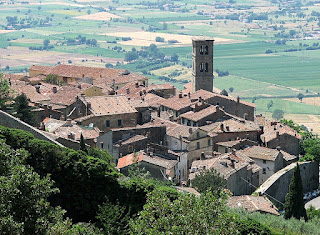Italian who designed Valletta, the fortified capital of Malta
 |
| Francesco Laparelli found himself in demand as a military architect |
Laparelli designed the campanile - bell tower - for Cortona’s duomo but turned his talents towards military engineering after serving as an officer under Cosimo de’ Medici during the battle for control of the Republic of Siena in the 1550s.
He went on to serve on Cortona’s city council and worked with other engineers on the Fortezza del Girifalco above the city. The cost of the fortress and other work on the city walls eventually bankrupted the city but Laparelli’s reputation was established.
He was summoned to Rome by Pope Pius IV in 1560 on the recommendation of Gabrio Serbelloni, the pope’s cousin and a condottiero with whom Laparelli had worked in Cortona.
Pius IV commissioned him to restore the fortifications at Civitavecchia, Rome’s main port, to build defences for the mouth of the Tiber river and to direct the strengthening of fortifications around the Vatican and the new suburb of Borgo Pio.
In 1565 he completed the reinforcement of the cylindrical Castel Sant'Angelo, now a familiar Rome landmark, and collaborated with Michelangelo on the huge dome of St Peter's Basilica, with particular focus on ensuring it was a stable structure.
 |
| Modern Valletta, capital of Malta, still resembles the fortress-city that was planned by Laparelli |
The Grand Knight, Jean Parisot de la Valette, favoured rebuilding the existing defences but Laparelli calculated that it would need 4,000 labourers working 24 hours a day just to make basic repairs and proposed that a new fortification on the Sciberras Peninsula could be built at a much cheaper cost. Such a fortification, he said, would enable Malta to be defended against any new incursion by the Turks with just 5,000 soldiers, far fewer than the 12,000 soldiers and 200 horses previously required to protect the island.
Laparelli’s design was for a city built on a grid plan with wide, straight streets, surrounded by ramparts and with the fort of St Elmo rebuilt at the tip of the peninsula. A ditch, later renamed the Ġnien Laparelli as a tribute to him, was added to protect the landward end of the peninsula.
 |
| The monument to Laparelli and his assistant, Girolamo Cassar, in Valletta |
Born into one of Cortona’s wealthiest and most illustrious families, Laparelli would have one day hoped to return to his home city, where he still owned considerable land and estates, but met with an early death in Crete, where he was staying when he contracted plague at the age of 49 in 1570.
He was unable to see his designs reach fruition in Valletta, where his work was continued by his Maltese assistant, Girolamo Cassar. Both he and Cassar are commemorated with a monument between Valletta’s Parliament House and the ruins of its old Royal Opera House, sculpted by John Grima and unveiled in 2016.
 |
| Laparelli's campanile towers over the small hilltop city of Cortona, his place of birth |
Cortona, Laparelli’s home town, was founded by the Etruscans, making it one of the oldest cities in Tuscany. Its Etruscan Academy Museum displays a vast collection of bronze, ceramic and funerary items reflecting the town’s past. The museum also offers access to an archaeological park that includes city fortifications and stretches of Roman roads. Outside the museum, the houses in Via Janelli are some of the oldest houses still surviving in Italy. Powerful during the mediaeval period, Cortona was defeated by Naples in 1409 and then sold to Florence. Characterised by its steep narrow streets, Cortona’s hilltop location - it has an elevation of 600 metres (2,000 ft) - offers sweeping views of the Valdichiana, including Lago Trasimeno, where Hannibal ambushed the Roman army in 217 BC during the Second Punic War.
 |
| Castel Sant'Angelo, which Laparelli reinforced before leaving for Malta, is a well-known Rome landmark |
Castel Sant’Angelo was originally built as a mausoleum for the Roman Emperor Hadrian and his family on the right bank of the Tiber between 134 and 139 AD. There is a legend that the Archangel Michael appeared on top of the mausoleum, sheathing his sword as a sign of the end of the plague of 590, which is how the castle acquired its present name. Pope Nicolas III commissioned a covered fortified corridor, the Passetto, to link it to the Vatican and Pope Clement VII was able to use it to escape from the Vatican during the siege of Rome by Charles V’s troops in 1527. Castel Sant’Angelo was used as the setting for the third act of Giacomo Puccini’s 1900 opera Tosca, during which the heroine leaps to her death from the ramparts.
Also on this day:
1498: The birth of soldier Giovanni dalle Bande Nere
1622: The birth of mathematician and scientist Vincenzo Viviani
1801: The birth of philosopher and politician Vincenzo Gioberti
(Picture credits: Valletta by MarcinCzerniawski, Castel Sant'Angelo by Rainhard2 via Pixabay; monument by No Swan So Fine, Cortona by Patrick Denker via Wikimedia Commons)
.jpeg)












